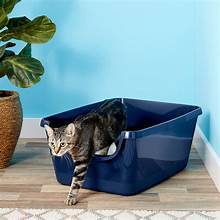
12 Common Litter Box Mistakes Every Cat Owner Should Avoid
Share
As cat owners, we all want the best for our feline friends. The litter box is one of the most critical aspects of your cat’s daily life, yet it’s often an area where many of us unintentionally make mistakes. The litter box isn’t just a place for your cat to do their business; it’s a sanctuary where they should feel safe and comfortable. Here are 12 common litter box mistakes that you might be making and tips on how to avoid them.
1. Using a Litter Box That’s Too Small
It’s easy to think a smaller litter box will save space, but it might be too cramped for your cat. Ideally, a litter box should be 1 to 1.5 times the length of your cat’s body. This size allows your cat to move around comfortably, dig, and cover their waste without feeling restricted.
2. Choosing a Litter Box with Difficult Access
Covered or high-sided litter boxes may appeal to us, but they can cause anxiety for cats. Cats rely heavily on their sight when using the litter box because it's a vulnerable time for them. A covered box limits their visibility, potentially leading to litter box aversion. Opt for an open box to ensure your cat feels secure and can easily see their surroundings.
3. Picking a Box with High Sides
While high-sided boxes can prevent litter from spilling out, they can be challenging for older cats to enter and exit. Consider a box with a lower entry point that’s easier for your cat to access, especially as they age.
4. Placing the Litter Box Near Food or Water
In small apartments, it might be tempting to place the litter box near your cat’s food and water bowls, but cats dislike this arrangement. Think about it: Would you want your kitchen and bathroom in the same space? To make your cat more comfortable, keep the litter box in a separate location.
5. Positioning the Litter Box in Noisy or Busy Areas
Cats prefer quiet, low-traffic areas when they use the litter box. Avoid placing the box near noisy appliances like washing machines or in busy hallways. Instead, choose a quiet corner where your cat can feel relaxed and undisturbed.
6. Using Uncomfortable Litter
Some types of litter, such as silica, can be uncomfortable for your cat’s paws, especially if the grains are sharp. You can test the comfort level by pressing your hand into the litter. If it’s uncomfortable for you, it’s likely uncomfortable for your cat too. Always opt for soft, fine-grained litter that won’t hurt your cat’s paws.
7. Using Scented Litter
While scented litter might smell pleasant to us, it can be overwhelming for cats, whose sense of smell is much more sensitive. Additionally, the scent can mask the natural odors that make cats feel secure. Stick to unscented litter to keep your cat comfortable.
8. Not Providing Enough Litter Boxes
One litter box per cat, plus one extra, is the general rule of thumb. This ensures that your cats always have a clean and accessible option. If one box becomes too dirty or is in an undesirable location, your cat will have an alternative. Multiple boxes can prevent accidents around the house.
9. Using the Wrong Amount of Litter
It’s crucial to use the right amount of litter—typically between 5 to 7 cm (about 2 to 3 inches) deep. Too little litter can make it difficult for your cat to cover their waste, while too much can overwhelm them. Check the manufacturer’s instructions for guidance, or use the recommended depth as a rule of thumb.
10. Using Plastic Liners in the Litter Box
While plastic liners can make cleanup easier, they can be frustrating for cats who like to dig. Your cat’s claws can catch on the liner, causing stress and potentially tearing the bag. It’s better to skip the liner and just clean the box regularly.
11. Not Adapting the Litter Box as Your Cat Ages
As your cat gets older, they might need a different litter box setup. An older cat may require a box with a lower entry point for easier access. Additionally, you should monitor their waste more closely as changes in their stool or urine can indicate health issues.
12. Training Your Cat to Use the Toilet
It might sound amusing, but teaching your cat to use the toilet can lead to problems. This practice goes against their natural instincts to bury their waste, and it can hide signs of health issues. Plus, keeping the toilet lid up all the time isn’t practical. Stick to the litter box—it’s safer and healthier for your cat.
Conclusion
By avoiding these common litter box mistakes, you can help ensure that your cat remains happy and stress-free. A comfortable, well-maintained litter box setup is essential for your cat’s health and well-being. Pay attention to your cat’s preferences and make adjustments as needed, and you’ll both enjoy a cleaner, happier home.
